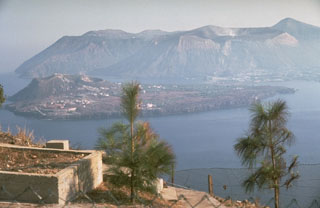Report on Vulcano (Italy) — June 1995
Bulletin of the Global Volcanism Network, vol. 20, no. 6 (June 1995)
Managing Editor: Richard Wunderman.
Vulcano (Italy) Fumarole observations and measurements
Please cite this report as:
Global Volcanism Program, 1995. Report on Vulcano (Italy) (Wunderman, R., ed.). Bulletin of the Global Volcanism Network, 20:6. Smithsonian Institution. https://doi.org/10.5479/si.GVP.BGVN199506-211050
Vulcano
Italy
38.404°N, 14.962°E; summit elev. 500 m
All times are local (unless otherwise noted)
SVE members who visited Gran Cratere on the Fossa Cone on 21 May observed the fumarole zone that extends from the floor of the lower crater to the rim of the upper crater and onto the NE flanks of the outer crater. Fumarolic activity has remained steady for several months with maximum temperatures of 500-600°C. Although the E-W fissure inside the crater (near the fumarole area) still appeared to be moving, scientists at Palermo University reported no increased seismicity or inflation.
Periodic fumarole surveys made by Marino Martini within the "La Fossa" crater between April 1993 and April 1995 showed a significant decrease in temperatures. Fumarole emissions during this period exhibited increased H2O and CO2 gas with a corresponding decrease in volcanic gases (table 3). Marino suggested that the changes were caused by increased permeability, allowing additional shallow groundwater to dilute the fluids eventually emitted at the surface. Increased vapor pressure could affect the precarious stability of the NW slopes of the crater, a serious potential hazard.
Table 3. Fumarole temperatures and gas compositions at Vulcano, April 1993 and April 1995. Courtesy of Marino Martini.
| Component | April 1993 | April 1995 |
| Temperature | 635°C | 476°C |
| H2O vol. % | 88.80 | 90.93 |
| CO2 % dry gas | 88.96 | 96.25 |
| H2S | 1.72 | 0.82 |
| SO2 | 3.97 | 0.90 |
| HCl | 1.89 | 0.82 |
| HF | 0.29 | 0.12 |
| B | 0.035 | 0.040 |
| H2 | 1.30 | 0.21 |
| N2 | 1.35 | 0.64 |
| CO | 0.078 | 0.027 |
Geological Summary. The word volcano is derived from Vulcano stratovolcano in Italy's Aeolian Islands. Vulcano was constructed during six stages over the past 136,000 years. Two overlapping calderas, the 2.5-km-wide Caldera del Piano on the SE and the 4-km-wide Caldera della Fossa on the NW, were formed at about 100,000 and 24,000-15,000 years ago, respectively, and volcanism has migrated north over time. La Fossa cone, active throughout the Holocene and the location of most historical eruptions, occupies the 3-km-wide Caldera della Fossa at the NW end of the elongated 3 x 7 km island. The Vulcanello lava platform is a low, roughly circular peninsula on the northern tip of Vulcano that was formed as an island beginning more than 2,000 years ago and was connected to the main island in about 1550 CE. Vulcanello is capped by three pyroclastic cones and was active intermittently until the 16th century. Explosive activity took place at the Fossa cone from 1898 to 1900.
Information Contacts: Henry Gaudru, Societe Volcanologique Europeenne (SVE), C.P. 1 - 1211 Geneva 17, Switzerland; Marino Martini, Department of Earth Sciences, University of Florence, Via G. La Pira 4, 50121 Florence, Italy.

